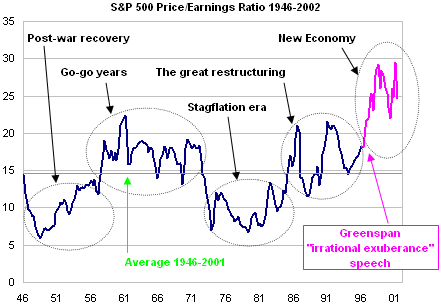The best reasons for the current era of high equity valuations aren’t very good. Just a few weeks before the great stock market crash of 1929, America’s first celebrity economist, Irving Fisher, made one of history’s worst market calls when he said, “Stock prices have reached what looks like a permanently high plateau.” From the top in 1929 to the bottom in 1932, the broad stock market lost 89% of its value.
Another bad market call of historic proportions was made by our own era’s celebrity economist, Alan Greenspan, when he warned in a December 1996 speech of “irrational exuberance.” After the wrenching boom-and-bust markets from 1999 to present, many investors mistakenly regard Greenspan’s remarks as having been prescient. But the reality is that the broad market is 44% higher today than it was on the day he made that speech.
 While stock prices have advanced since Greenspan’s speech, equity valuations have advanced even more. The chart at left shows the modern history of the price/earnings ratio of the S&P 500 (based on trailing 12-month operating earnings). After four distinct valuation epochs corresponding to four phases in the development of the US economy, Greenspan’s speech marked the beginning of a fifth epoch. The fifth epoch has lasted now more than five years, and within it we have seen a wide range of valuations. But even at the lowest points of that range, throughout this epoch investors have been willing to pay more for corporate earning than ever before.
While stock prices have advanced since Greenspan’s speech, equity valuations have advanced even more. The chart at left shows the modern history of the price/earnings ratio of the S&P 500 (based on trailing 12-month operating earnings). After four distinct valuation epochs corresponding to four phases in the development of the US economy, Greenspan’s speech marked the beginning of a fifth epoch. The fifth epoch has lasted now more than five years, and within it we have seen a wide range of valuations. But even at the lowest points of that range, throughout this epoch investors have been willing to pay more for corporate earning than ever before.
Even after significant losses in 2000, 2001 and so far in 2002, p/e of the S&P 500 Index remains today about as high today as it has ever been. The p/e of 29.5 registered last year-end was an all-time record. To update Fisher, it is as though “Stock valuations have reached what looks like a permanently high plateau.”
This is the valuation conundrum: what is there about stocks now that make investors willing to value them so highly, and for so long? Is there any possible rational explanation for today’s epoch of high equity valuations?
Perhaps investors believe that corporate earnings can grow faster now than they have in the past. That’s certainly possible, but so far in this epoch of high valuation it hasn’t materialized.
 In modern history the average annual operating earnings growth rate for the S&P 500 has been 6.2%, and the current epoch seems no different. As the chart above shows, today’s epoch of high equity valuations began shortly after a strong short-term surge in earnings growth. But there have been stronger surges, such as in the late 1940’s when America was returning to a peacetime economy. And besides, since Greenspan’s speech the rate of earnings growth has fallen sharply — and yet valuations remain near all-time highs.
In modern history the average annual operating earnings growth rate for the S&P 500 has been 6.2%, and the current epoch seems no different. As the chart above shows, today’s epoch of high equity valuations began shortly after a strong short-term surge in earnings growth. But there have been stronger surges, such as in the late 1940’s when America was returning to a peacetime economy. And besides, since Greenspan’s speech the rate of earnings growth has fallen sharply — and yet valuations remain near all-time highs.
Perhaps investors believe — even if earnings growth will be no greater in the future than it has been in the past — that stocks will be less risky. All else equal, a rational investor will indeed value an earnings stream more highly if he can get it with less risk. This seems absurd on the face of it, as any investor who has lived through the boom-and-bust of the last three years can tell you from experience.
And the statistics bear out this intuition. Over modern history the volatility — or risk — of the S&P 500 (measured as the annualized standard deviation of daily returns observed over 30-day periods) has averaged 11.8%. As the chart above demonstrates, volatility has stayed above that long-term average during the recent epoch of high valuation more consistently than at any other time.
 Another possible explanation is capital gains tax policy. Capital gains taxes were lowered in 1997, near the beginning of the present epoch of high valuation. A lower capital gains tax rate raises the total after-tax return of equity investing because investors get to keep a greater share of the profits, even if corporate earnings remain unchanged — so valuations should, indeed, have move higher. But the modest cut in capital gains taxes enacted in 1997 hardly explains the quantum upward shift observed in valuations. Besides, the 1997 cut only moved rates back toward where they had been a decade earlier when valuations were much lower.
Another possible explanation is capital gains tax policy. Capital gains taxes were lowered in 1997, near the beginning of the present epoch of high valuation. A lower capital gains tax rate raises the total after-tax return of equity investing because investors get to keep a greater share of the profits, even if corporate earnings remain unchanged — so valuations should, indeed, have move higher. But the modest cut in capital gains taxes enacted in 1997 hardly explains the quantum upward shift observed in valuations. Besides, the 1997 cut only moved rates back toward where they had been a decade earlier when valuations were much lower.
In a very general sense there are some factors that could explain the gradual elevation of valuation throughout the 1980s and 1990s — but they say relatively little about the timing and magnitude of the present epoch of high valuation.
The most persuasive to me is that, even if markets themselves have not become any less risky, investors have learned to handle risk better thanks to index funds, international investing, and other diversification technologies. These have made equities effectively less risky to hold, and thus more valuable.
At the same time, advances in financial theory have taught investors more about the nature of risk, and the way risk is compensated in efficient markets. This has undoubtedly made investors more tolerant of risk, and willing to accept greater levels of risk in their portfolios. This makes equities more valuable because investors will demand a smaller risk premium to hold them.
Having ruled three major explanations out — and ruled only two minor explanations in — we are still left with the valuation conundrum. Why are stocks so much more highly valued today than they have been historically?
This answer is important, because any investor who makes any serious attempt to price stocks based on their underlying businesses can’t evade the need to also make guesses about how the market will value those businesses in the future. And when valuations are as high as they are today compared to historical standards — for no apparent good reason — even the most optimistic forecasts for underlying business growth have to take into account the risk that valuations may compress back toward the long-term norms.









